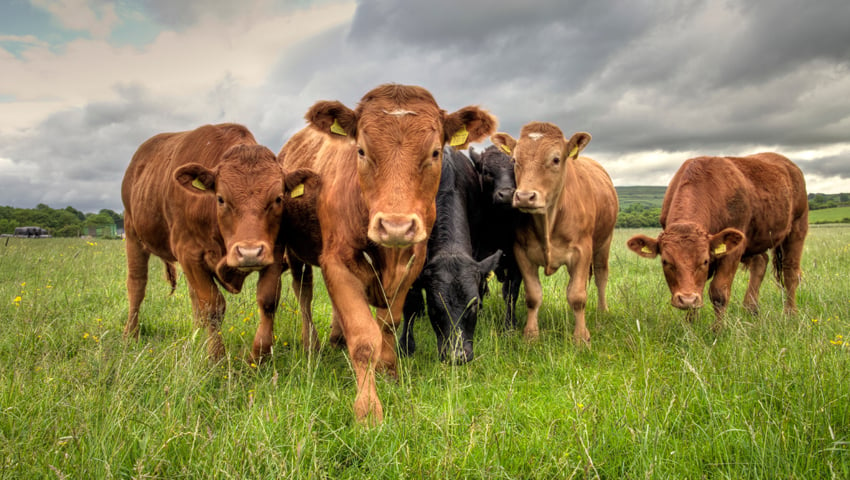COMMENTARY, By Nikki Yoxall
Nikki Yoxall farms at Howemill in Aberdeenshire, Scotland. She also works with Pasture for Life.
Nikki’s article first appeared as a Twitter thread under Nikki’s handle @howemill
THE current debate between George Monbiot and Allan Savory is leaving folk on both sides struggling to feel heard. So I thought I’d try and explain a bit more about why the grazing Monbiot refers to and the grazing Savory refers to are not the same.
Generally, research into grazing relies on models that are based on set stocked systems – simply the number of animals per acre – with an assumption that they are there continuously. Continuous grazing has been pretty standard for a lot of farmers for a fairly long time. In set stocked systems, animals are either there or not – it becomes a binary choice of graze or exclude and most grazing research relies on this binary: livestock presence versus livestock exclusion with no shades of grey in between.
However, lots of farmers are now rotationally grazing, mob grazing, cell grazing or various other iterations of graze-plus-rest. That’s the key word here. REST. This means animals are sometimes there, sometimes not, and plant recovery is key. Here we find the shades of grey.
Holistic Planned Grazing, as Savory promotes, is slightly more complex again. It’s not just about rest, it’s about the optimal rest-plus-graze combo to achieve whatever aims have been set as part of the holistic plan. For me, that means abundance and diversity to nourish my community.
The trouble is that these adaptive grazing management approaches that equally value grazing and resting have been massively under researched. Managing for REST rather than GRAZING requires a mindset shift – and most researchers (especially the clever modelling folk) have no idea this is a thing (or if they do, they don’t know how to model it).
I know this because I had this conversation with some of Europe’s best agricultural systems modelling scientists back in December 2022.
Two other issues also occur here.
One is that these systems are truly adaptive by nature, so studying them can be difficult within current experimental design protocol, where consistency is key. The trouble is that consistency isn’t really natural so doesn’t fit adaptive systems.
The second is that research and soil health changes both take time. Farmers have been engaged in this for a good few years, but researchers like Drs Paige Stanley and Sarah Morgan have only been researching this fairly recently, so results are early and limited.
So there is a knowledge gap – but an absence of research doesn’t mean something isn’t true, it just means it hasn’t been researched. Academics understand this… but it seems journalists less so.
So to give an example. Think of a nominal metre square of field. In my farm system this will only be grazed for FOUR days a year. For the other 361 days it will have no livestock on it and will be doing its clever ecosystem functioning thing.
This is the same for every metre square of the land we graze.
We do this to create as much rest and recovery in the system as we possibly can, for wildlife habitat (see our vole tunnel evidence) and for plant expression – we see LOADS of flowers by doing this.
For us, an electric fence is the key tool to help us control the grazing. By splitting fields into smaller sections using an electric fence, we can control the daily stocking density – the number of animals per area of land per day. N.B. This is not the same as the stocking rate – the number of animals across all land for the year.
Because of the types of habitat and outcomes we are managing for, our stocking density varies depending where we are in the grazing plan. We use low density for natural tree regen sites and high density for low biologically active soils that need a bit of a wake up.
Farmers and graziers managing these graze-plus-rest systems are all very different; all managing for different things.
These adaptive systems have been shown to reduce greenhouse gas emissions for finishing cattle (Dr Paige Stanley), and increase carrying capacity of the land and extend the grazing season (Dr Sarah Morgan), which is all great news!
Conversely, it’s been found that more land is needed than for intensive finishing (but lots of well managed grasslands are a good thing) and individual animal weights may be lower (but you can have more of them).
What’s important though is that these adaptive grazing approaches consistently deliver for farmers looking to have more productive grasslands (across a range of productivity measures). They also seem to offer more resilience in a changing climate – according to the farmers who are managing them.
So basically the very adaptive nature of these approaches means farmers have a lot more control of both grazing impact AND rest and recovery.
They can use grazing (and not grazing) as a tool to achieve their desired outcomes..
In short – we need more research to better help understand the shades of grey that farmers can create through more adaptive and context dependent grazing systems.
